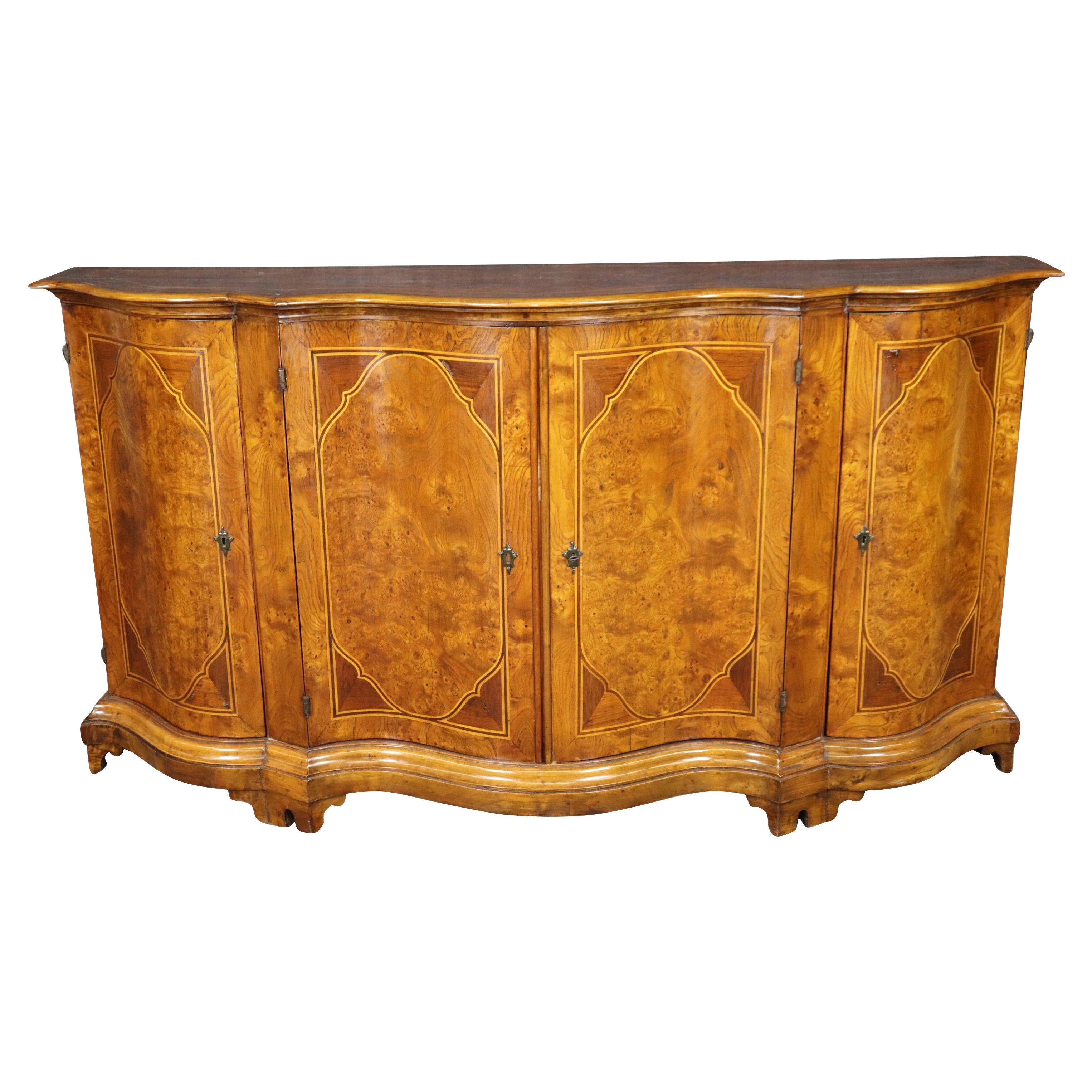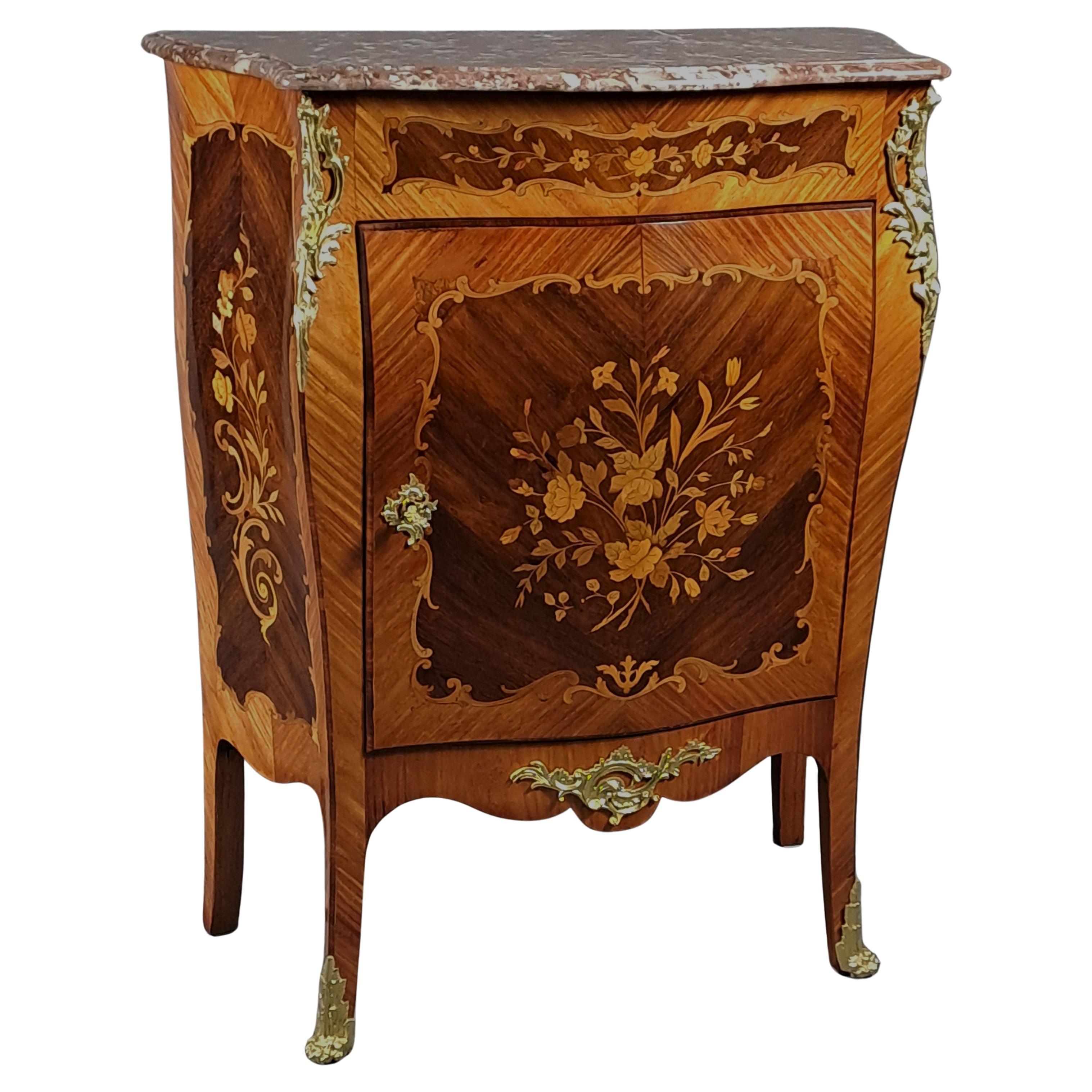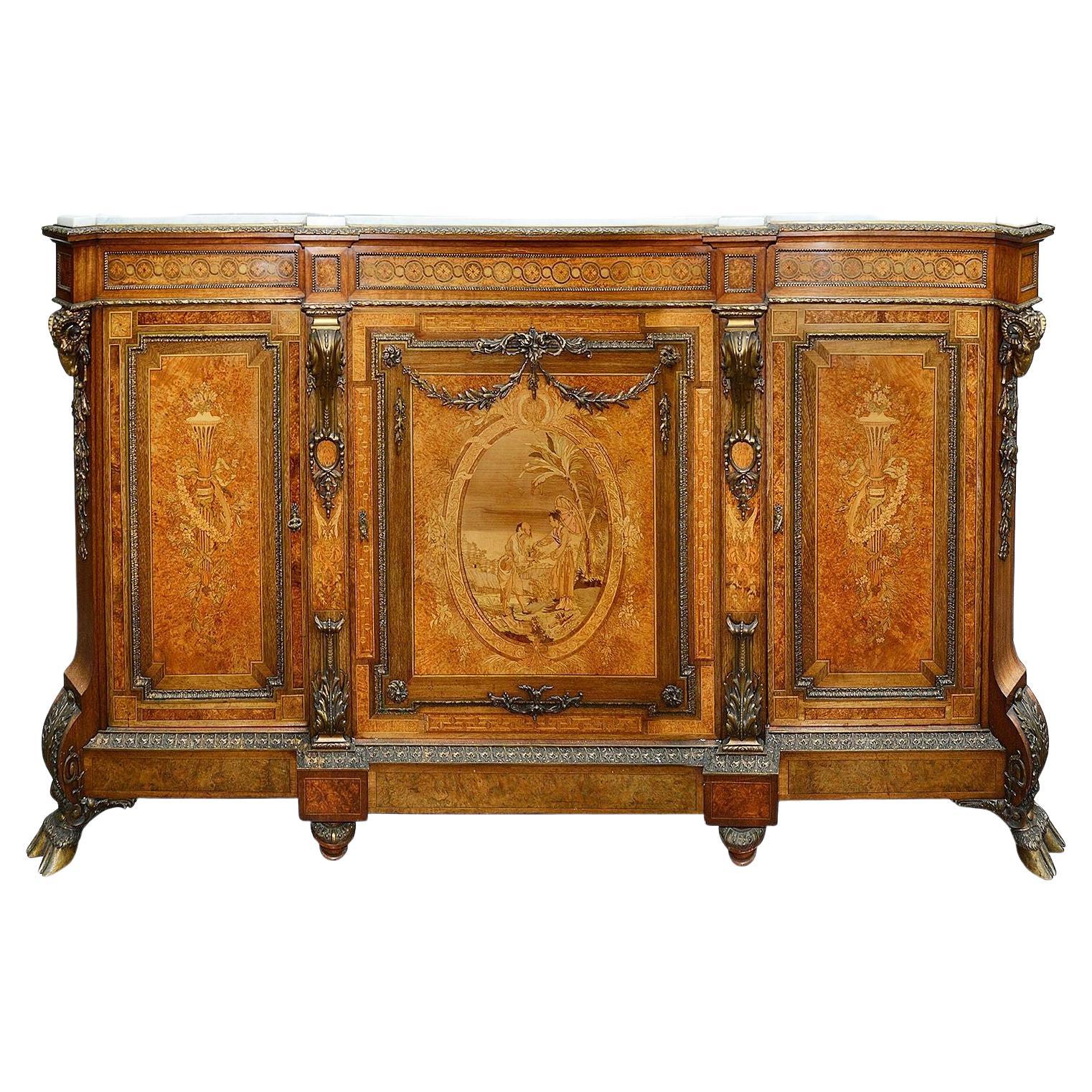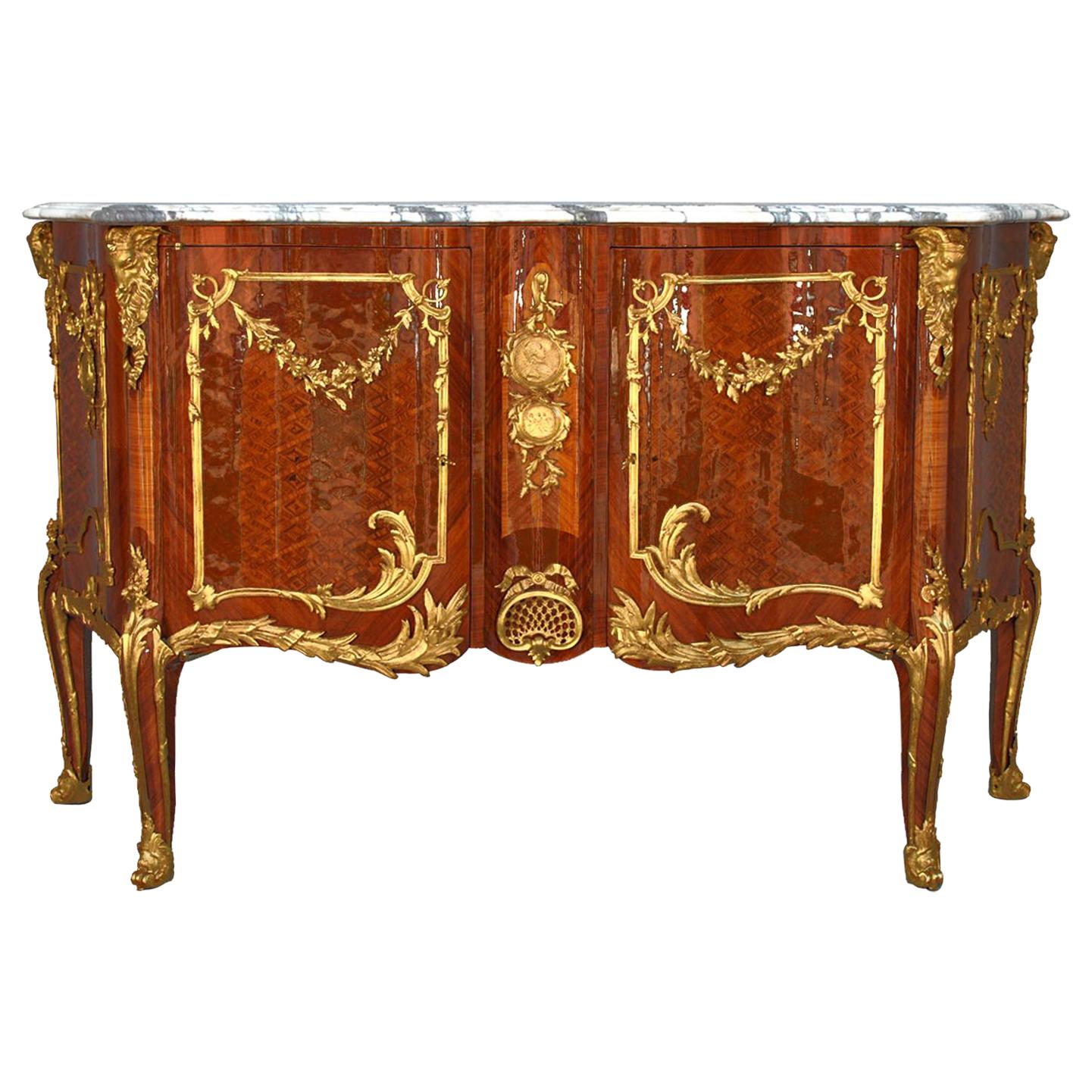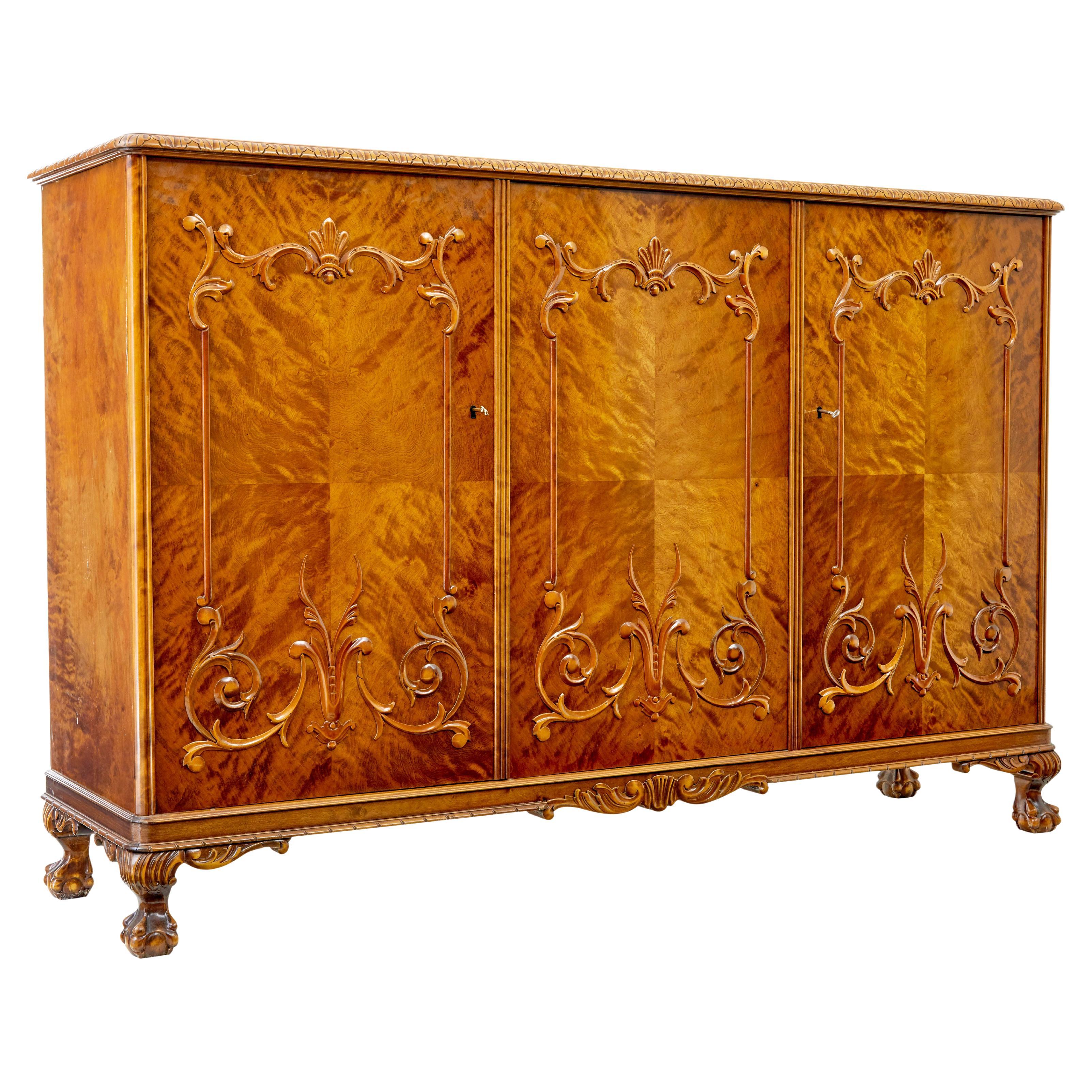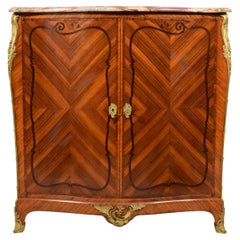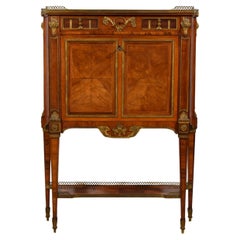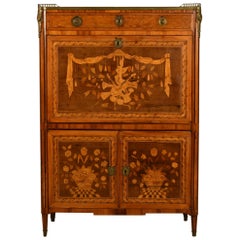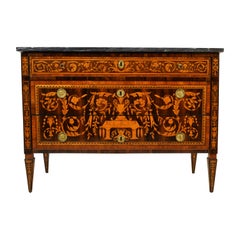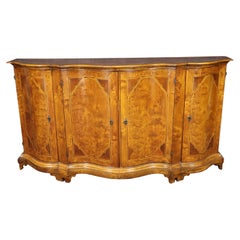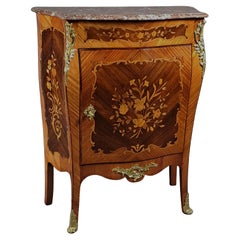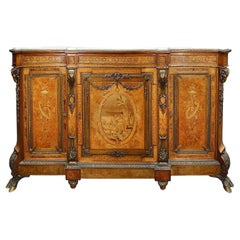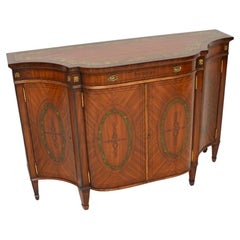Items Similar to 19th Century, Italian Rococo Style Inlay Wood Sideboard
Want more images or videos?
Request additional images or videos from the seller
1 of 21
19th Century, Italian Rococo Style Inlay Wood Sideboard
$19,754.22
£14,657.73
€16,500
CA$27,589.73
A$29,921.71
CHF 15,716.02
MX$363,451.91
NOK 196,661.13
SEK 185,167.43
DKK 125,647.58
About the Item
19th Century, Italian Rococo Style Inlay Wood Sideboard
This sideboard was made in the Venetian area in the 19th century. The shaped model takes up the stylistic characteristics of the Venetian Rococo furniture of the eighteenth century. Entirely made of walnut wood, it is decorated with refined inlays in different colours that create phytomorphic frames and figures. The structure has four doors, inside of which there are two shelves per compartment. The profile is moved and the pillars are protruding, decorated with grotesque tarps. Each door has an inlaid frame with floral and phyto-morphic motifs and in the center of a box in burr are figures of men and women with noble clothes characteristic of the eighteenth-century Venice, placed on pedestals and topped by a small canopy. The plan following the movement of the front is also adorned with marquetry along the outer band with ornaments in a vegetable form. In the central part, in burl, stands an inlay depicting a banquet scene with two nobles sitting in front of a lady. The scene, probably taken from an engraving, is surrounded below by phytomorphic elements and, in the center, a flowers composition. The four feet are arched and moved.
This large and spacious piece of furniture is very decorative and pleasant for its sinuous and elegant lines and its elegant inlays. It can be placed in different environments, such as living rooms and dining rooms, corridors and entrances but also studios and bedrooms. It can be presented with some objects on the floor, such as lamps, vases and cache-pots, sculptures, candlesticks and watches. On the wall, above the cabinet, a mirror or paintings could be placed, so as to soften the overall effect.
- Dimensions:Height: 40.56 in (103 cm)Width: 64.18 in (163 cm)Depth: 21.66 in (55 cm)
- Style:Rococo (In the Style Of)
- Materials and Techniques:
- Place of Origin:
- Period:
- Date of Manufacture:19th Century
- Condition:Wear consistent with age and use.
- Seller Location:IT
- Reference Number:1stDibs: LU4405241539852
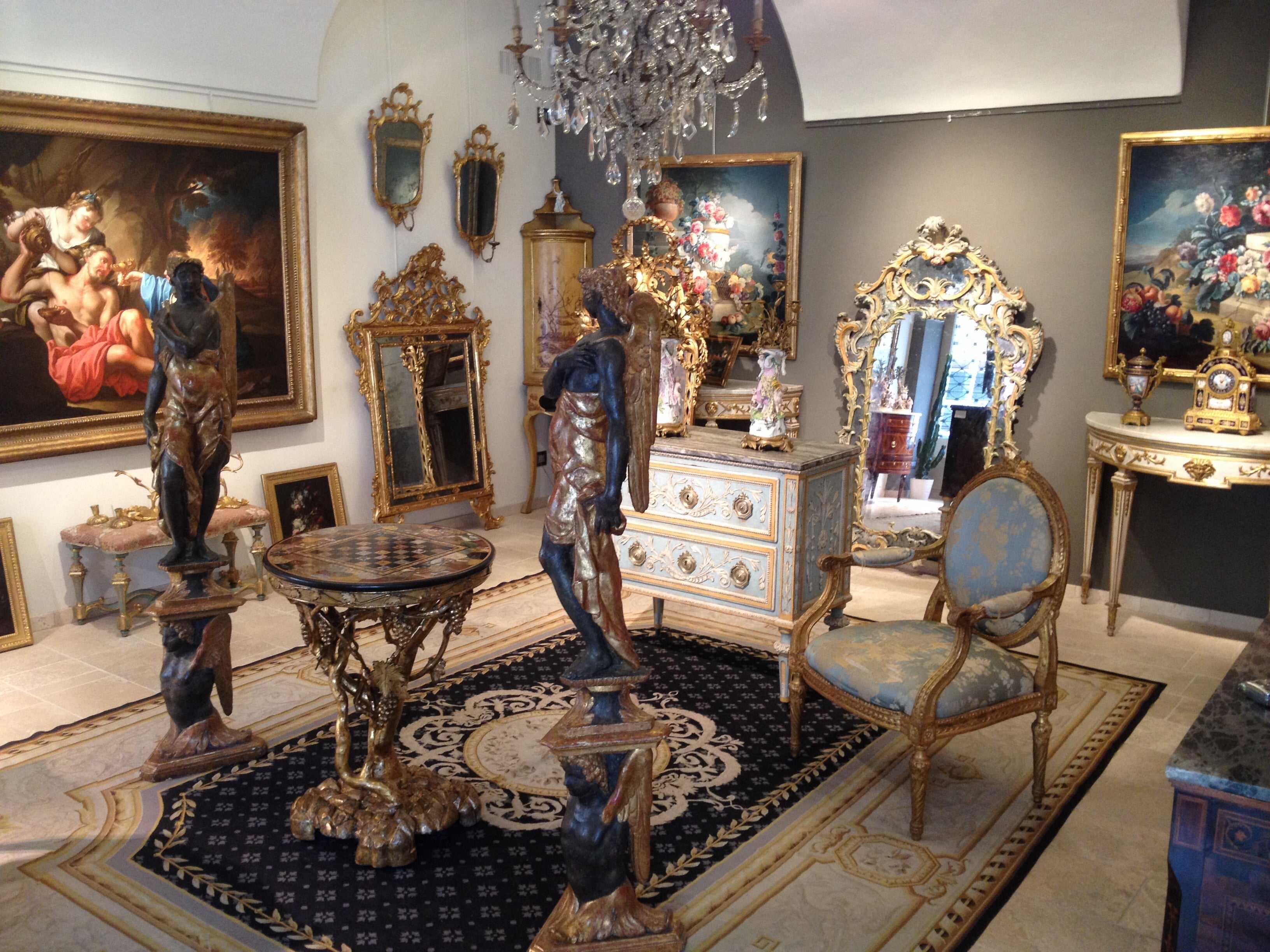
About the Seller
5.0
Vetted Professional Seller
Every seller passes strict standards for authenticity and reliability
Established in 1980
1stDibs seller since 2019
56 sales on 1stDibs
Typical response time: <1 hour
- ShippingRetrieving quote...Shipping from: Italy
- Return Policy
Authenticity Guarantee
In the unlikely event there’s an issue with an item’s authenticity, contact us within 1 year for a full refund. DetailsMoney-Back Guarantee
If your item is not as described, is damaged in transit, or does not arrive, contact us within 7 days for a full refund. Details24-Hour Cancellation
You have a 24-hour grace period in which to reconsider your purchase, with no questions asked.Vetted Professional Sellers
Our world-class sellers must adhere to strict standards for service and quality, maintaining the integrity of our listings.Price-Match Guarantee
If you find that a seller listed the same item for a lower price elsewhere, we’ll match it.Trusted Global Delivery
Our best-in-class carrier network provides specialized shipping options worldwide, including custom delivery.More From This Seller
View All19th century, French Louis XV style Veneered Wood Sideboard
Located in IT
19th century, French Louis XV style Veneered Wood Sideboard
This refined and elegant sideboard was made in France in the mid-19th century, in the Louis XV style.
It features a top m...
Category
Antique Mid-19th Century French Louis XV Buffets
Materials
Marble, Bronze
19th Century, French Louis XVI Style Wood Secretaire Sideboard
Located in IT
19th Century, French Louis XVI Style Wood Secretaire Sideboard
Rare veneered wood secretaire sideboard, France, late 18th century - early 19th century
Measurements: cm W 105 x H 11...
Category
Antique Early 19th Century French Louis XVI Cabinets
Materials
Wood
18th Century, French Louis XVI Inlaid Wood Secretaire with Marble Top
Located in IT
18th century, French Louis XVI inlaid wood secretaire with marble top and gilt bronzes.
This elegant secretaire Louis XVI was made in F...
Category
Antique Late 18th Century French Louis XVI Secretaires
Materials
Bronze
18th Century, Italian Neoclassical Inlaid Wood Chest of Drawers
Located in IT
18th century, Italian neoclassical inlaid wood chest of drawers
This refined neoclassical chest of drawers was done around the end of the 18th century in Genoa (Italy). The cabinet ...
Category
Antique Late 18th Century Italian Neoclassical Commodes and Chests of Dr...
Materials
Wood, Boxwood, Nutwood
$40,226 Sale Price
20% Off
18th Century, Italian Baroque Veneering and Inlays Wood Commode
Located in IT
18th Century, Italian Baroque Veneering and Inlays Wood Commode
This elegant and refined commode was crafted in Piedmont, Italy, in the first half of the 18th century, during the Ba...
Category
Antique Early 18th Century Italian Baroque Commodes and Chests of Drawers
Materials
Wood
$22,028 Sale Price
20% Off
18th Century Italian Neoclassical Wood Dresser Attributed to Francesco Bolgiè
By Francesco Bolgié
Located in IT
18th century Italian neoclassical carved, lacquered and gilded wood dresser attributed to Francesco Bolgiè (1752?-1834).
The fine and elegant commode is made of finely carved, lacquered and gilded wood. It presents several stylistic and material elements characteristic of the wooden works and of the furniture present in the Piedmont area, between the end of the 18th century and the beginning of the 19th century. The richness of the ornaments, the gold leaf, the iconographic program and the significant level of cabinet making that characterizes this furniture are testimony of a wealthy client and the valuable work of a sculptor at the service of noble and royal families. Stylistically can be attributed to the famous italian sculptor Francesco Bolgiè (1752-1834).
The front of the furniture and the two side are characterized by a complex decorative architecture. Two horizontal perimeter bands show gilded carved geometric patterns and palmettes on a blue lacquered backdrop. The low frame, in the centre and on the front, has a half-moon element inside which is finely carved a lion with two cupids and laurel branches. Near the corners, at the top, are carved a female faces, while at the bottom are some bees. The fretwork of the vertical bands draws strings that support a bunch of grapes with vine leaves. The side walls are lacquered in ochre yellow and, at the centre, a frame with acanthus leaves outlines a lacquered space in the tones of the ancient rose violaceous, with in the centre an ornate leaf with fine girali. On the four sides of this frame four large golden flowers harmonize the together.
The front, similar in composition, has a yellow ochre background, internal frame with palmettes and four flowers. The large internal space, lacquered in antique pink, shows in the center a woman’s fece with a composition of grapes and wheat ears; from the face depart fine phytomorphic girals with racemes, bunches of grapes and vine leaves. The nozzle of the original lock, placed on the front of the cabinet and on top, is in gilded bronze, chiselled with ribbon motif. The front panel opens downwards. The interior of the cabinet, entirely lacquered in red, has a shelf and therefore two compartments. The red color cinnabar deliberately recalls the characteristic Chinese lacquer, at the time much loved for the decorations to cineseria furniture. The special folding lock system, which allows the opening and closing of the front door, is the original one.
The commode rests on four conical wood legs witch are carved with acanthus leaves and small ramage, gilded and lacquered.
The top of the furniture is in grey marble bardiglio valdieri, lithotype that had great success in Piedmont, in the north of Italy, since the middle of the 18th century. On it were usually exposed bronzes, candlesticks, watches and sculptures.
The sculpted subjects refer to a precise iconographic programme.
The female head is identifiable in Ceres, Mother Terra, which in classical iconography is depicted with the head surrounded by a sert of wheat ears and a cluster of grapes. Ceres or Demeter in Greek, sister of Zeus, in Greek mythology is the goddess of fertility, the guardian of crops, protector of agriculture and wheat, constant nurse of youth and of the green earth, author of the cycle of seasons, life and death, protector of marriage and sacred laws.
The representation of Ceres, and its meaning, are linked to bees, symbol of virtue and chastity, allegory of Mother Earth, rebirth, mercy and justice. Just as the leaves of the vine and its fruits: in many cultures, from Greco-Roman to Christianity, the vine is a symbol of well-being, fruitfulness and blessing; it represents an abundant life and the joy that flows from it; it reflects the desire for fertility and beauty. It is also a sign of devotion to the fruits of the spirit and protection from evil. Fullness, wisdom, youth, maturation, prosperity are all images associated with the vine. Sacrifice, faith and good will are the qualities required for the vine to bear fruit.
The inverted bezel shows the iconographic image of Amor Vincit...
Category
Antique Late 18th Century Italian Neoclassical Dressers
Materials
Giltwood, Wood
You May Also Like
Fantastic Italian Inlaid Olivewood Rococo Period Sideboard Circa 1820s Era
Located in Swedesboro, NJ
This fantastic Italian Rococo period sideboard, dating to the early 19th century circa 1820s, showcases the elegance and artistry of fine European cabinetmaking. Crafted from richly ...
Category
Antique 1820s Italian Rococo Sideboards
Materials
Iron
$4,796 Sale Price
20% Off
Louis XV Style Sideboard In Marquetry And Gilt Bronze
Located in BARSAC, FR
Louis XV style curved sideboard in rosewood and palisander marquetry with floral bouquets on the front and sides.
Opening a door.
Beautiful gilded and chiseled bronze ornamentation...
Category
Antique Late 19th Century French Louis XV Sideboards
Materials
Marble, Bronze
Fine Quality 19th Century Classical Inlaid Side Cabinet
Located in Brighton, Sussex
A fine quality 19th century marquetry inlaid, marble topped credenza / side cabinet. Having wonderful gilded ormolu moldings and classical Rams head mounts. Each of the three doors w...
Category
Antique 19th Century French Neoclassical Revival Sideboards
Materials
Mahogany
Antique Sheraton Style Painted Satinwood Sideboard
Located in London, GB
A stunning antique Sheraton style painted satinwood sideboard. This was made in England, it likely dates from around the 1950’s.
The quality is outstanding, this is extremely well m...
Category
Vintage 1950s French Louis XV Sideboards
Materials
Satinwood
Transition Style Sideboard with Marquetry Inlaid and Gilt Bronze
By Charles Cressent
Located in Marseille, FR
Sideboard inlaid in Transition style richly decorated with gilded bronzes on white marble top veined with double Corbin beak. Geometric marquetry decorations. This chest of drawers d...
Category
20th Century French Louis XV Sideboards
Materials
Rosewood
Swedish mid 20th century rococo revival birch sideboard
Located in Debenham, Suffolk
Good quality Scandinavian birch sideboard in the rococo taste circa 1940.
Comprising of a single door and a double door compartment. Top surface with decorative carved edge leads t...
Category
Mid-20th Century Swedish Rococo Revival Sideboards
Materials
Wood, Birch, Pine
More Ways To Browse
19th Century Wood Italian Furniture
Italian Inlay Furniture
Italian Rococo Dining
Venetian Rococo Furniture
19th Century Venetian Mirror Italy
Antique Burr Box
Wall Watches
English Pedestal Sideboard
Florence Knoll Bassett
Georgian Oak Sideboard
Ib Kofod Larsen For G Plan
Italian Contemporary Wood And Travertine Sideboard
Ligne Roset Storage
Lovig Sideboard
Rosewood Cabinet Sliding Door
Solid Teak Sideboard
Used Furniture Nottingham
Victorian Mahogany Chiffonier
